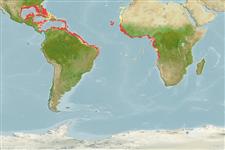Classification / Names
Common names from other countries
Main reference
Size / Weight / Age
Max length : 94.0 cm TL male/unsexed; (Ref. 40637); common length : 50.0 cm TL male/unsexed; (Ref. 5217); max. published weight: 8.5 kg (Ref. 40637)
Environment
Marine; reef-associated; depth range ? - 650 m (Ref. 3686), usually 50 - 300 m (Ref. 26999)
Climate / Range
Subtropical, preferred 26°C (Ref. 107945); 30°N - 14°S, 98°W - 15°E (Ref. 34024)
Distribution
Western Atlantic: off the continental coast from Florida, USA and the Gulf of Mexico to northern South America, including islands in the Caribbean. Eastern Atlantic: off Senegal to Angola.
Countries | FAO areas | Ecosystems | Occurrences | Introductions
Short description
Dorsal
spines
(total): 0;
Dorsal
soft rays
(total): 109-117;
Anal
spines: 0;
Anal
soft rays: 86 - 90. Body completely covered with small, imbricate, cycloid scales; barbels present on snout (6) and chin (6); branchiostegal rays 8; median basibranchial tooth patch absent; developed gill rakers on first arch 4 or fewer; pelvic fin rays inserted at about level of preopercle, well behind eye (Ref. 34024). Ventral fins dark, gradually becoming darker at the extreme blackish edge (Ref. 13608).
IUCN Red List Status (Ref. 115185)
Threat to humans
Harmless
Human uses
Fisheries: minor commercial; gamefish: yes
More information
ReferencesAquacultureAquaculture profileStrainsGeneticsAllele frequenciesHeritabilityDiseasesProcessingMass conversion
Tools
Special reports
Download XML
Internet sources
Estimates of some properties based on models
Phylogenetic diversity index
PD50 = 0.5156 many relatives (e.g. carps) 0.5 - 2.0 few relatives (e.g. lungfishes)
Trophic Level
3.9 ±0.6 se; Based on size and trophs of closest relatives
Resilience
Medium, minimum population doubling time 1.4 - 4.4 years (K=0.19)
Vulnerability
Moderate to high vulnerability (52 of 100)
Price category
